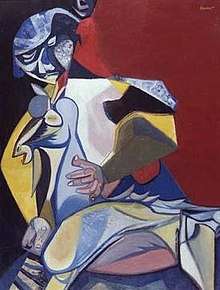Robert Colquhoun
Robert Colquhoun (20 December 1914 – 20 September 1962) was a Scottish painter, printmaker and theatre set designer.
Robert Colquhoun | |
|---|---|
 Woman with a Young Goat, 1948 | |
| Born | 20 December 1914 |
| Died | 20 September 1962 (aged 47) |
| Nationality | Scottish |
Colquhoun was born in Kilmarnock and was educated at Kilmarnock Academy. He won a scholarship to study at the Glasgow School of Art, where he met Robert MacBryde with whom he established a lifelong homosexual relationship[1] and professional collaboration, the pair becoming known as "the two Roberts".
He joined MacBryde on a travelling scholarship to France and Italy from 1937 to 1939, before serving as an ambulance driver in the Royal Army Medical Corps during the Second World War. After being injured, he returned to London in 1941 where he shared studio space with MacBryde. The pair shared a house with John Minton and, from 1943, Jankel Adler.
Colquhoun's early works of agricultural labourers and workmen were strongly influenced by the colours and light of rural Ayrshire. His work developed into a more austere, Expressionist style, heavily influenced by Picasso, and concentrated on the theme of the isolated, agonised figure. From the mid-1940s to the early 1950s he was considered one of the leading artists of his generation. Along with that of MacBryde, the work of Colquhoun was regularly shown at the Lefevre Gallery in London.
At the height of their acclaim they courted a large circle of friends - including Michael Ayrton, Francis Bacon, Lucian Freud and John Minton as well as the writers Fred Urquhart[2], George Barker, Elizabeth Smart and Dylan Thomas - and were renowned for their parties at their studio (77 Bedford Gardens). Colquhoun was also a prolific printmaker, producing a large number of lithographs and monotypes throughout his career.
During and after the Second World War he worked with MacBryde on several set designs. These included sets for Gielgud's Macbeth, King Lear at Stratford and Massine's Scottish ballet Donald of the Burthens, produced by the Sadler's Wells Ballet at Covent Garden in 1951. During the 1950s their artistic reputation went into serious decline, and their heavy drinking made any serious effort to paint impossible. According to their friend Anthony Cronin they were often close to destitution.
Robert Colquhoun died, an alcoholic, in relative obscurity in London in 1962. MacBryde moved to Dublin, where he was killed in a traffic accident in 1966. Their friend Anthony Cronin describes them with respect and affection in his memoir Dead as Doornails.[3]
Works
- Mysterious Figures (1960)
- Woman with Leaping Cat (1945)
References
- Devine, Rachel (7 March 2010). "Openly homosexual when it was still illegal to be so and gay people were actively persecuted, they made little attempt to disguise their relationship". London, UK: Sunday Times. Retrieved 7 March 2010.
- "About Fred Urquhart". The University of Edinburgh. Retrieved 27 September 2017.
- Cronin, Anthony Dead as Doornails Lilliput Press reissue 1999
External links and further reading
- 50 paintings by or after Robert Colquhoun at the Art UK site
- Bristow, Roger (2009). The Last Bohemians: The Two Roberts - Colquhoun and MacBryde. Bristol, UK: Sansom & Co. ISBN 1906593191.
- Biography at the Tate Gallery
- Robert Colquhoun on the Gazetteer for Scotland
- The Roberts at the Scottish National Gallery (exhibition catalogue)